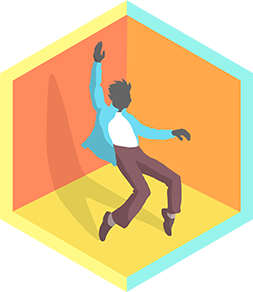Dance Coding Challenge
Design and code a short dance routine using simple symbols or block commands, test and perform it to learn sequencing, loops, and debugging.



Step-by-step guide to Dance Coding Challenge
Create a Dance Party Scene! | Code.org
Step 1
Pick 4 to 6 dance moves you like and write each move name on your paper.
Step 2
Draw a simple symbol or color next to each move name so each move has its own code.
Step 3
Write each symbol on its own index card so every move has one card.
Step 4
Lay out eight cards in a line to create your first dance sequence.
Step 5
Choose two or four cards to repeat and mark the first card of that group with "x2" to make a loop.
Step 6
Open your coding app or website.
Step 7
Start a new project in the coding app or website.
Step 8
Create block commands or type simple commands that match each symbol you drew.
Step 9
Arrange the commands in the same order as your eight cards and include the loop you marked.
Step 10
Run the code or read the command sequence and try the moves once to see how it looks.
Step 11
If a move is out of order or timing feels wrong then change the order of the cards or the commands to fix it.
Step 12
Decide how many beats each move takes and write the beat number on each card.
Step 13
Update your code so each command includes the correct beat count.
Step 14
Practice performing your dance with music until the moves line up smoothly with the beats.
Step 15
Share your finished creation on DIY.org.
Final steps
You're almost there! Complete all the steps, bring your creation to life, post it, and conquer the challenge!


Help!?
I don't have index cards or a coding app — what can I use instead?
If you don't have index cards, cut paper into card-sized rectangles or use sticky notes for 'Write each symbol on its own index card', and if you don't have a coding app you can write the commands on the cards and act them out or use a free block app like Scratch for 'Open your coding app or website'.
My moves don't line up with the music — how do I fix timing or order?
When moves are out of sync after you 'Run the code or read the command sequence', rearrange the cards as described in 'If a move is out of order...' and write beat numbers on each card in 'Decide how many beats each move takes' then 'Update your code' to match those beats.
How can I change this activity for different ages?
For younger children use 4 simple picture-based moves on big cards and skip the coding app, while older kids can use 6 moves, add 'x2' loops, assign precise beat counts, and implement the sequence in a coding app as in 'Create block commands' and 'Arrange the commands'.
How can we make the Dance Coding Challenge more creative or advanced?
Enhance the project by adding costume or lighting cues on the cards from 'Draw a simple symbol or color', programming conditional branches or tempo-triggered commands in your coding app, and recording the final performance to share on DIY.org.
Watch videos on how to do the Dance Coding Challenge
💃 How to Code Your Own Digital Dance Performance in Scratch! | Code Along Jr. with Black Girls Code
Facts about block-based coding for kids
🕺 Dance is full of patterns and timing—choreography is basically a human-friendly algorithm of steps.
🐞 Debugging a dance routine means testing, spotting mistakes (wrong steps or timing), and fixing them—just like fixing bugs in code.
🔁 In coding, a loop repeats commands; dancers and choreographers use repeating motifs to build memorable routines.
📝 Labanotation (by Rudolf Laban) is a system for writing down dances so movements can be preserved and shared—like sheet music for bodies.
🧩 Scratch is a block-based coding language made for kids to snap commands together to make sprites move, hop, and dance.
How do I set up and run a Dance Coding Challenge at home?
What materials do I need for a Dance Coding Challenge?
What ages is the Dance Coding Challenge suitable for?
What are the benefits of doing a Dance Coding Challenge?


One subscription, many ways to play and learn.
Only $6.99 after trial. No credit card required


